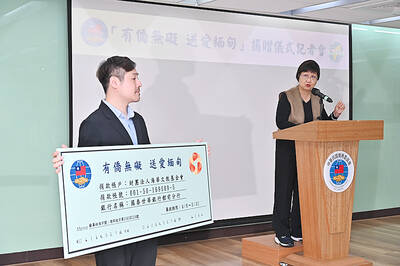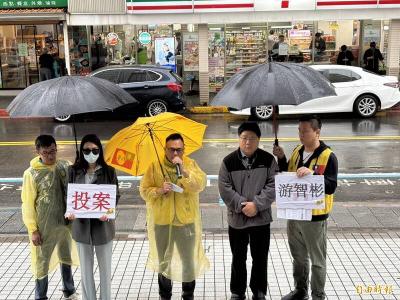President Ma Ying-jeou’s (馬英九) interpretation of the Cairo Declaration, issued on Dec. 1, 1943, as the legal basis of Taiwan’s “return” to the Republic of China (ROC) after World War II was not only incorrect, but also dangerous because his rhetoric was exactly the same as that of Beijing, pro-independence advocates said yesterday.
“[Ma’s interpretation] fits right in with the ‘one China’ framework, which would be interpreted by the international community as saying Taiwan is part of China because hardly anyone would recognize the China in ‘one China’ framework as referring to the ROC,” Taiwan Society President Chang Yen-hsien (張炎憲), a former president of the Academia Historica, told a press conference.
The Treaty of San Francisco, signed on Sept. 8, 1951, should have been the only legal document to determine Taiwan’s status, not the Cairo Declaration in 1943, nor the Potsdam Declaration of 1945, Chang and other experts said at the press conference, held almost at the same time as a commemoration ceremony for the 70th anniversary of the First Cairo Conference, organized by the Presidential Office.

Photo: Wang Min-wei, Taipei Times
Since Ma took the same position on the declaration as Beijing, which cited it as the legal basis for Taiwan’s return to China, he is risking two important issues, said Vincent Chen (陳文賢), a professor at National Chengchi University’s Graduate Institute of Taiwan History.
“With Ma taking the same position, Beijing could bolster its argument about Chinese sovereignty over the Diaoyutai Islands (釣魚台), which it claimed had been returned to China along with Taiwan and Penghu in the declaration,” Chen said.
“[Ma’s] adherence to the ‘one-China’ framework could, in the long run, create a false perception among the international community that Taipei and Beijing would follow the post-World War II unification models of Vietnam and Germany and unify in the future,” he said.
While the declaration, which was released in the form of a press communique after the meeting of Chiang Kai-shek (蔣介石), then-US president Franklin Roosevelt and then-British prime minister Winston Churchill in Cairo, said that “all the territories Japan has stolen from the Chinese, such as Manchuria, Formosa, and the Pescadores, shall be restored to the Republic of China,” the ROC referred to the country which was in the state of war with Japan, not the country which is now in Taiwan with different people and territory from “the old ROC,” Taiwan Nation Alliance convener Yao Chia-wen (姚嘉文) said.
The context of the Cairo Declaration would be better interpreted by examining the post-World War II developments and comments made by leaders of involved countries, the advocates said.
Yao said that Churchill told the British parliament on Feb. 1, 1955, that he would not accept the view that the declaration could be used as a binding document to claim that China has sovereignty over Taiwan, adding that Japan’s prime minister and foreign minister had also made it clear that Japan renounced its claim over Taiwan and did not hand it to anyone.
Since the declaration was not a treaty but a communique, it did not transfer Taiwan’s sovereignty, Provisional Government of Formosa executive secretary Sim Kian-tek (沈建德) said.
Moreover, the communique was not signed by any leaders because Roosevelt and Churchill had different views about how to handle Taiwan’s future, Sim said.

DEFENSE: The National Security Bureau promised to expand communication and intelligence cooperation with global partners and enhance its strategic analytical skills China has not only increased military exercises and “gray zone” tactics against Taiwan this year, but also continues to recruit military personnel for espionage, the National Security Bureau (NSB) said yesterday in a report to the Legislative Yuan. The bureau submitted the report ahead of NSB Director-General Tsai Ming-yen’s (蔡明彥) appearance before the Foreign and National Defense Committee today. Last year, the Chinese People’s Liberation Army (PLA) conducted “Joint Sword-2024A and B” military exercises targeting Taiwan and carried out 40 combat readiness patrols, the bureau said. In addition, Chinese military aircraft entered Taiwan’s airspace 3,070 times last year, up about

A magnitude 4.3 earthquake struck eastern Taiwan's Hualien County at 8:31am today, according to the Central Weather Administration (CWA). The epicenter of the temblor was located in Hualien County, about 70.3 kilometers south southwest of Hualien County Hall, at a depth of 23.2km, according to the administration. There were no immediate reports of damage resulting from the quake. The earthquake's intensity, which gauges the actual effect of a temblor, was highest in Taitung County, where it measured 3 on Taiwan's 7-tier intensity scale. The quake also measured an intensity of 2 in Hualien and Nantou counties, the CWA said.

The Overseas Community Affairs Council (OCAC) yesterday announced a fundraising campaign to support survivors of the magnitude 7.7 earthquake that struck Myanmar on March 28, with two prayer events scheduled in Taipei and Taichung later this week. “While initial rescue operations have concluded [in Myanmar], many survivors are now facing increasingly difficult living conditions,” OCAC Minister Hsu Chia-ching (徐佳青) told a news conference in Taipei. The fundraising campaign, which runs through May 31, is focused on supporting the reconstruction of damaged overseas compatriot schools, assisting students from Myanmar in Taiwan, and providing essential items, such as drinking water, food and medical supplies,

New Party Deputy Secretary-General You Chih-pin (游智彬) this morning went to the National Immigration Agency (NIA) to “turn himself in” after being notified that he had failed to provide proof of having renounced his Chinese household registration. He was one of more than 10,000 naturalized Taiwanese citizens from China who were informed by the NIA that their Taiwanese citizenship might be revoked if they fail to provide the proof in three months, people familiar with the matter said. You said he has proof that he had renounced his Chinese household registration and demanded the NIA provide proof that he still had Chinese